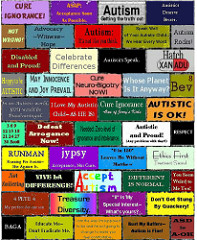Dear Diary,
Wait a minute, this is a migraine diary; useful and important, but not such a “dear” topic.
Dear Diary,
Today I had another migraine. The symptoms included:
As mentioned, I’m putting together a diary of migraine details for an upcoming appointment with a specialist. The other week I had one so bad that my son had to take me to my GP for a Toradol injection, to be taken with a fresh dose of Imitrex — “fresh” in both meanings, because earlier I had taken my last and slightly-expired pill. I’d planned on asking the pharmacist to order a refill, but of course, had been unable to go into work at the grocery! (The irony.)
“Have you made an appointment with a neurologist?” asked my doc.
“Headache speshlist; don’ remember whom.” I held my wallet in front of my nose and squinched one eye open a millimeter to pull out the correct business card.
“Oh good, that’s just the person I wanted you to see. Takes forever to get an appointment, though.”
“In April,” I mumbled.
“Yeup; takes forever. Okay, I’ll have the nurse come in with the injection, and I’m writing you a ‘script for some more Imitrex.”
” ‘Ank-you.”
When I do get to see this new specialist, I want to be armed with a good data set so we can maximise the efficacy of our first appointment. But to do that, I had to figure out what kinds of data would be needed. This in turn meant researching the various types of headaches, migraines, and symptoms. I got to learn lots of great new words!
If the headache is bilateral (both sides of the head), then it’s a regular tension-type headache. I’ve had some intractable ones that linger for a couple-three days, despite various medications.
Unilateral headaches (just one side of the head) are the migraine sort.
There are the icepick migraines that feel like someone just stabbed you in the head. Although intense, they are mercifully brief — just a minute, though there can be several repeats throughout the day.
Migraines can be temporally divided into three stages: the prodrome or early-warning symptoms, the migraine itself, and the postdromal after-effects. If I wake up with a migraine, then I don’t have the benefit of prodromal symptoms to alert me to take some medication and stave off the worst effects. However, one of the benefits to keeping data sheets is the ability to suss out what sorts of symptoms are prodromal, so I can have better self-awareness.
A persistent tension headache can turn into a migraine (ugh). Eating much wheat also seems to be a trigger for me; a small cooky isn’t bad, but a couple slices of pizza will do me in later (not to mention digestive hoo-hahs as the gluten works through my kishkas). Barometric pressure drops — especially those that bounce back up from a swiftly-passing storm — are notorious for making my ears and head hurt.
The cognitive and mood factors can be less obviously related to migraine prodrome: brain fog, depressive state, insomnia, or light sensitivity. You might think these would be pretty obvious, but the problem with chronic pain (from hypermobility+osteoarthritis+TMJ, especially combined with 11-13 hour work days) is that one gets into those viscous circles of pain-sleep problems-depressive states. Throw in everyday hyperacussis and UV-sensitivity, and sometimes it’s hard to sort out what is which. “Ain’t we got fun.”
Once I started researching various migraine symptoms, I had a much better means of both identifying and describing the various symptoms I experience.
One thing that quickly became apparent was that like snowflakes, no two migraines were precisely the same. This is interesting from an objective point of view, but it also means that I have to spend a bit of effort to verbally identify the symptoms I experience during each migraine, and then shortly thereafter note them. Although a cognitive task that I cannot always perform throughout the entirety of the experience, it does afford me the opportunity to detach part of my consciousness to that objective state, which gives me one step of remove from the intensity of the experience. (My research background is useful in so many ways.)
An Aura can include visual disturbances such as:
Scintillating scotoma the classic flickering/shimmering/sparkling arc, zig-zag or castle crenelation effect;
Drifting phosphenes phosphenes are “stars” you see if you stand up too quickly or sneeze; phosphenes can also refer to the geometric patterns that happen when you press on your closed eyes;
Diplopia just the fancy word for double vision;
Oscillopsia when objects appear to oscillate, vibrate or bounce;
Photophobia “the light, augh! too bright!”
Allodynia pain from nothing in particular, or something that wouldn’t normally cause pain, “augh the sheet’s touching my arm!”;
Osmophobia “the smells, augh! too overpowering!”
Olfactory hallucinations smelling things that aren’t really there;
Phonophobia when even the clattering of dust particles falling is too loud;
Hyperacussis I startle overmuch at sudden or sharp noises — well, even more so than usual;
Auditory hallucinations hearing things that aren’t there, nor are related to my tinnitus;
Synæsthesia Feeling sounds, and other odd cross-sensory effects;
Paresthesias tingling or numb feeling like “pins and needles”, or like someone is yanking on my kneecaps or tendons;
Vertigo, nausea, vomiting, chills or clamminess;
Ataxia a “lack of order” or bad muscle coordination;
Disarthria / aphasia disarthria is trouble speaking clearly, and aphasia is problems with speaking and understanding, or making sense of reading things.
Once all that is over, there is the postdrome, or “migraine hangover”. I’ve no idea how one compares to a drinking hangover — I’ve never drunk that much! But it is something like having the flu: weakness, generalized muscle aches, laterality confusion (right v left), fine-motor difficulties, exhaustion, lack of appetite, intense thirst, intermittent strabismus (wandering eye), temporary dyslexia / reading comprehension, auditory processing lags, concentration problems, or once in a while, feeling energetic — “wow, I’m no longer in pain!”
Then of course, the was the issue of creating a useful data sheet, one that was both complete and easily used — and this is where my dual backgrounds in behavioral research and typography+layout blend well.
As with any sort of biological data, it is important to note the frequency, intensity and duration. In addition to those classic factors, there are also the sorts of factors that one more often considers in ecology: the type, season (if any – only a data set of more than a year can determine that), and the extent, in this case, the extent of the disability that results from migraines.
I’m sorted the pain and disablement into three levels:
1 annoying pain, workable
2 moderate pain, reduced work
3 severe pain, incapacitating.
With the diary, I can then sort out the frequency, intensity and duration of the issues. So far I’m relizing that it’s much more of a problem than I had realized. It’s not so much that one gets used to pain, but that one gets used to being in pain, to headaches as a way of life.
Damn, but April’s a long ways off.








